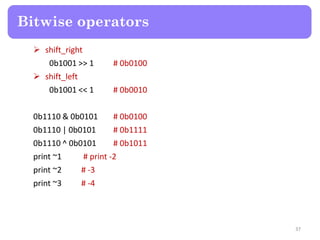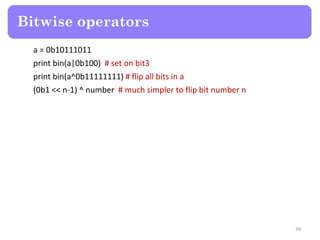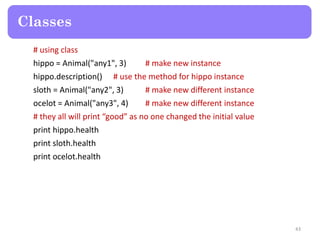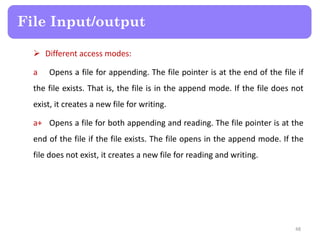Raspberry Pi - Lecture 5 Python for Raspberry Pi
- 1. Prepared by: Mohamed AbdAllah Raspberry pi interfacing Lecture 5: Python for raspberry pi 1
- 2. Python Agenda Python syntax. Strings and console output. Conditional and control flow. Functions. Lists and dictionaries. Loops. Bitwise operators. Classes. File Input/output 2
- 5. #!/usr/bin/python • It should be written at the start of any python script to tell the shell to execute the script using python, so the script should have execute permission. print “Hello” • Prints Hello to console x = 3 • Define integer variable x with value 3 y = 4.5 • Define float variable y with value 4.5 z = True • Define Boolean variable z with value True x = 5/2 • Value of x will be 2 as operation is all on integers Python syntax 5
- 6. x = 5.0/2 • Value of x will be 2.5 x = float(5)/2 • Value of x will be 2.5 # comment • # is used to comment out any line “””Comment multiple lines””” • “”” any number of lines “”” is used to comment out any number of lines. Python syntax 6
- 7. x = 10 + 20 • X is sum of 10 and 20 x = 4 ** 2 • X is 4 to the power of 2 x = 101 % 2 • X is 101 modulo 2 which will equal 1 Python syntax 7
- 8. Strings and console output 8
- 9. var = “Hello Python” • Put string “Hello Python” in variable var c = “Hello”[0] • Put character at index zero of string “Hello” which is ‘H’ in variable c, so c will contain the value ‘H’ c = var[4] • c will have the value at index 4 which is ‘o’ len(var) • Returns the length of the given string d = str(32) • d will contain the string representation of the value 32, so d will contain “32” as a string. Strings and console output 9
- 10. print var.lower() • Print string in variable var with all letters lower case. print var.upper() • Print string in variable var with all letters upper case. mystr = var + “Scripting” • Concatenate strings, value of mystr will be “Hello Python Scripting” print “Welcome” + “ to” + “ python” • Prints Welcome to python mystr = var[2:len(var)] • Variable mystr will contain string inside var from index 2 (third character) till the end of the string inside var. Print “value1 is %s, value2 is %s” %(var1, var2) • Prints the values inside variables var1 and var2. Strings and console output 10
- 11. Date and time # import is used to include external library to be used inside our script from datetime import datetime now = datetime.now() print now.year print now.month print now.day print '%s/%s/%s' % (now.month, now.day, now.year) print ("%s:%s:%s") % (now.hour, now.minute, now.second) print ("%s/%s/%s %s:%s:%s") % (now.month, now.day, now.year, now.hour, now.minute, now.second) Strings and console output 11
- 12. Conditional and control flow 12
- 13. Comparators > == <= < • Compare between two values, returns True or False and, or operators • Combine between 2 or more conditions not operator • Returns the inverse of the condition • not is evaluated first, and is evaluated next, or is evaluated last. So use Parentheses better Conditional and control flow 13
- 14. If syntax if x>10 : #note the ‘:’ print “Greater” # note the indentation (4 white spaces) elif x<10 : print “Less” else : print “Equal” Conditional and control flow 14
- 15. Take input from user name = raw_input("What's your name?") # returns string integer = int(raw_input("Enter number: ")) # convert returned string to integer integer = input("enter integer") # returns integer if name.isalpha() # check that name contains alphabetical characters only Conditional and control flow 15
- 16. Functions 16
- 17. Python functions import math print math.sqrt(25) # print square root of 25 from math import sqrt # to be able to use sqrt by its name print sqrt(25) import math # Imports the math module everything = dir(math) # Sets everything to a list of function from math print everything # Prints all available functions in math module Functions 17
- 18. Python functions maximum = max(-2,3,1,15) # return maximum of given values minimum = min(3,7,2,9) # return maximum of given values absolute = abs(-42) # return absolute value of given number print type(3) # prints <type 'int'> print type(2.4) # prints <type 'float'> print type("Hello") # prints <type 'str'> #no need to import any module to be able to use previous functions as they are built in functions. Functions 18
- 19. User defined functions def print_positive(arg) : # take one argument if agr>=0 : print arg return True # return value to the caller else : return False Functions 19
- 21. list = [item1, item2, item3] • Create list of the given 3 items list.append(newItem) • Add new element at the end of the list list[0:3] • Values of the list from index 0 and stop before index 3 list[:2] • Grabs the first two items list[3:] • Grabs the fourth through last items string_index = list.index(“mystring") • Find index of “mystring" Lists and dictionaries 21
- 22. list.insert(index, item) • insert item at index and shift all next items down by 1 list.sort() • sort list ascending list.remove(item3) • remove item3 from list Loop on all list items my_list = [1,9,3,8,5,7] for number in my_list: print 2 * number # print 2 18 6 16 10 14 Lists and dictionaries 22
- 23. students= {‘std1' : 90, ‘std2' : 85, ‘std2' : 93} • Assigning a dictionary with three key-value pairs to students print students[‘std1'] • Prints std1 grade which is 90 dict_name[new_key] = new_value • add new value to dictionary del dict_name[key_name] • delete key-value pair from dictionary dict_name[key] = new_value • change value Lists and dictionaries 23
- 24. a = [0, 1, 2, 3, 4, 5, 6, 7, 8, 9, 10, 11, 12, 13] # print even numbers in list for number in a : if number%2 == 0 : print number # loop on string characters for letter in “Mystring": print letter # print all letters each one on separate line Lists and dictionaries 24
- 25. # function take list as argument def count_small(numbers): # returns number of values less than 10 total = 0 for n in numbers: if n < 10: total = total + 1 return total num = [4, 8, 15, 16, 23, 42] small = count_small(num) print small # print number of values in list that are less than 10 Lists and dictionaries 25
- 26. # shop example shopping_list = ["banana", "orange", "apple"] stock = {"banana": 6, "apple": 0, "orange": 32} prices = {"banana": 4, "apple": 2, "orange": 1.5} def compute_bill(food) : # compute the total price of given food list total = 0 for item in food : # loop on all items in food list if stock[item]>0 : # if item exists in stock stock[item]-=1 # reduce stock by 1 total+=prices[item] # add item price to total return total Print compute_bill(shopping_list) Lists and dictionaries 26
- 27. n = [1, 3, 5] n.pop(1) # Returns 3 (the item at index 1) and remove it from list n.remove(1) # Removes 1 from the list, # NOT the item at index 1 del(n[1]) # Doesn't return anything, but removes item at index 1 Lists and dictionaries 27
- 28. def my_function(x): for i in range(0, len(x)): # loop on all indices in list x x[i] = x[i] * 2 # change value at index i with the double of this value return x # return the edited list Note range(6) # [0,1,2,3,4,5] range(1,6) # [1,2,3,4,5] range(1,6,3) # [1,4] from 1 to 6 with step 3 letters = ['a', 'b', 'c', 'd'] print " ".join(letters) # prints a b c d print "---".join(letters) # prints a---b---c---d Lists and dictionaries 28
- 29. # list comprehension evens_to_50 = [i for i in range(51) if i % 2 == 0] # list of even numbers till 50 my_list[::2] # from start to end with stride of 2 my_list[::-1] # from end to start with stride of 1 squares = [x**2 for x in range(5)] # contains squares of numbers from 0 to 4 Lists and dictionaries 29
- 30. Loops 30
- 31. Note # to use random numbers from random import randint coin = randint(0, 1) dice = randint(1, 6) Loops 31
- 32. count = 0 while count < 10 : # Add a colon print count # Increment count count +=1 # or while True : print count count +=1 if count >= 10: break #### using break Loops 32
- 33. count = 0 count = 0 while count < 3: num = random.randint(1, 6) print num if num == 5: print "Sorry, you lose!" break count += 1 else: print "You win!" ## will be executed only if didn't enter loop, or loop terminated normally, but it will not be executed if loop terminated by "break" statement, the same like "for/else" Loops 33
- 34. choices = ['pizza', 'pasta', 'salad', 'nachos'] print 'Your choices are:' for index, item in enumerate(choices): print index+1, item # >> Your choices are: 1 pizza 2 pasta 3 salad 4 nachos Loops 34
- 36. print 0b11 # print 3 print bin(2) # print bin() returns binary representation of a number (similar oct() hex()) #note you can't use the return as number any more print int("0b11001001", 2) # print the integer base ten of the given binary number Bitwise operators 36
- 37. shift_right 0b1001 >> 1 # 0b0100 shift_left 0b1001 << 1 # 0b0010 0b1110 & 0b0101 # 0b0100 0b1110 | 0b0101 # 0b1111 0b1110 ^ 0b0101 # 0b1011 print ~1 # print -2 print ~2 # -3 print ~3 # -4 Bitwise operators 37
- 38. # check value of bit 4 def check_bit4(input): mask = 0b1000 result = input & mask # using mask if result > 0: return "on" else: return "off" Bitwise operators 38
- 39. a = 0b10111011 print bin(a|0b100) # set on bit3 print bin(a^0b11111111) # flip all bits in a (0b1 << n-1) ^ number # much simpler to flip bit number n Bitwise operators 39
- 40. Classes 40
- 41. Class: is an object oriented programing concept, class means a collection of some attributes (variables) and methods (functions) that are related to the same physical meaning. Defining a class: means defining a new collection of attributes and methods that are related to each other to be used later. Using class: is done by making a variable (instance) of that class, one can make multiple instances of the same class and they are all independent. Classes 41
- 42. # define new class class Animal(object): # attributes section definition is_alive = True health = "good“ # init method, called automatically each time an instance is made of the class def __init__(self, name, age): #all methods must take (self) as first as this is the variable that points to the current instance self.name = name self.age = age # any methods are added here def description(self): print self.name print self.age Classes 42
- 43. # using class hippo = Animal("any1", 3) # make new instance hippo.description() # use the method for hippo instance sloth = Animal("any2", 3) # make new different instance ocelot = Animal("any3", 4) # make new different instance # they all will print “good” as no one changed the initial value print hippo.health print sloth.health print ocelot.health Classes 43
- 45. # Read from file my_file = open("output.txt", "r") # open file with read only permission print my_file.read() # read file content and print it my_file.close() # close file # Write to file my_file = open("output.txt", “r+") # open file with read / write permission my_file.write(“Hello”) # write hello to file my_file.close() # close file File Input/output 45
- 46. # make python close the file by itself after finishing with open("text.txt", "w") as textfile: textfile.write("Success!") if my_file.closed == False: # check if file not closed through closed attribute my_file.close() print my_file.closed # print closed attribute current value, it should now be True as the file is closed File Input/output 46
- 47. Different access modes: r Opens a file for reading only. The file pointer is placed at the beginning of the file. This is the default mode. r+ Opens a file for both reading and writing. The file pointer placed at the beginning of the file. w Opens a file for writing only. Overwrites the file if the file exists. If the file does not exist, creates a new file for writing. w+ Opens a file for both writing and reading. Overwrites the existing file if the file exists. If the file does not exist, creates a new file for reading and writing. File Input/output 47
- 48. Different access modes: a Opens a file for appending. The file pointer is at the end of the file if the file exists. That is, the file is in the append mode. If the file does not exist, it creates a new file for writing. a+ Opens a file for both appending and reading. The file pointer is at the end of the file if the file exists. The file opens in the append mode. If the file does not exist, it creates a new file for reading and writing. File Input/output 48
- 49. Mohamed AbdAllah Embedded Systems Engineer [email protected] 49





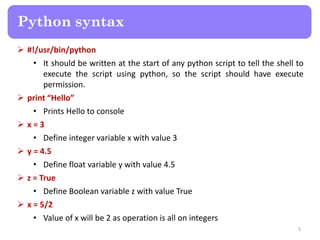
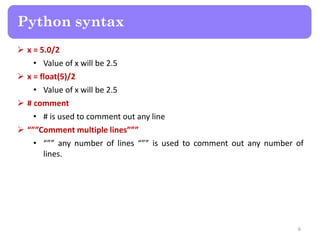


![ var = “Hello Python”
• Put string “Hello Python” in variable var
c = “Hello”[0]
• Put character at index zero of string “Hello” which is ‘H’ in variable c, so
c will contain the value ‘H’
c = var[4]
• c will have the value at index 4 which is ‘o’
len(var)
• Returns the length of the given string
d = str(32)
• d will contain the string representation of the value 32, so d will contain
“32” as a string.
Strings and console output
9](https://image.slidesharecdn.com/lecture5-pythonforraspberrypi-150819171856-lva1-app6891/85/Raspberry-Pi-Lecture-5-Python-for-Raspberry-Pi-9-320.jpg)
![ print var.lower()
• Print string in variable var with all letters lower case.
print var.upper()
• Print string in variable var with all letters upper case.
mystr = var + “Scripting”
• Concatenate strings, value of mystr will be “Hello Python Scripting”
print “Welcome” + “ to” + “ python”
• Prints Welcome to python
mystr = var[2:len(var)]
• Variable mystr will contain string inside var from index 2 (third
character) till the end of the string inside var.
Print “value1 is %s, value2 is %s” %(var1, var2)
• Prints the values inside variables var1 and var2.
Strings and console output
10](https://image.slidesharecdn.com/lecture5-pythonforraspberrypi-150819171856-lva1-app6891/85/Raspberry-Pi-Lecture-5-Python-for-Raspberry-Pi-10-320.jpg)
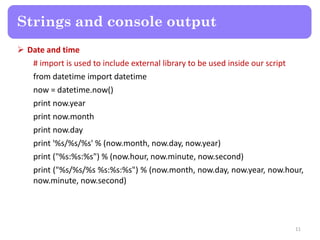

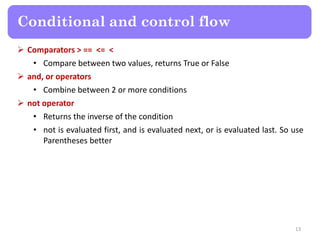

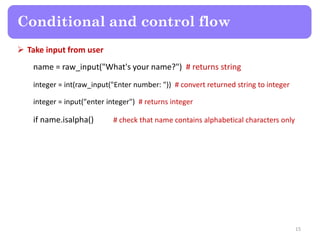





![ list = [item1, item2, item3]
• Create list of the given 3 items
list.append(newItem)
• Add new element at the end of the list
list[0:3]
• Values of the list from index 0 and stop before index 3
list[:2]
• Grabs the first two items
list[3:]
• Grabs the fourth through last items
string_index = list.index(“mystring")
• Find index of “mystring"
Lists and dictionaries
21](https://image.slidesharecdn.com/lecture5-pythonforraspberrypi-150819171856-lva1-app6891/85/Raspberry-Pi-Lecture-5-Python-for-Raspberry-Pi-21-320.jpg)
![ list.insert(index, item)
• insert item at index and shift all next items down by 1
list.sort()
• sort list ascending
list.remove(item3)
• remove item3 from list
Loop on all list items
my_list = [1,9,3,8,5,7]
for number in my_list:
print 2 * number # print 2 18 6 16 10 14
Lists and dictionaries
22](https://image.slidesharecdn.com/lecture5-pythonforraspberrypi-150819171856-lva1-app6891/85/Raspberry-Pi-Lecture-5-Python-for-Raspberry-Pi-22-320.jpg)
![ students= {‘std1' : 90, ‘std2' : 85, ‘std2' : 93}
• Assigning a dictionary with three key-value pairs to students
print students[‘std1']
• Prints std1 grade which is 90
dict_name[new_key] = new_value
• add new value to dictionary
del dict_name[key_name]
• delete key-value pair from dictionary
dict_name[key] = new_value
• change value
Lists and dictionaries
23](https://image.slidesharecdn.com/lecture5-pythonforraspberrypi-150819171856-lva1-app6891/85/Raspberry-Pi-Lecture-5-Python-for-Raspberry-Pi-23-320.jpg)
![a = [0, 1, 2, 3, 4, 5, 6, 7, 8, 9, 10, 11, 12, 13]
# print even numbers in list
for number in a :
if number%2 == 0 :
print number
# loop on string characters
for letter in “Mystring":
print letter # print all letters each one on separate line
Lists and dictionaries
24](https://image.slidesharecdn.com/lecture5-pythonforraspberrypi-150819171856-lva1-app6891/85/Raspberry-Pi-Lecture-5-Python-for-Raspberry-Pi-24-320.jpg)
![# function take list as argument
def count_small(numbers): # returns number of values less than 10
total = 0
for n in numbers:
if n < 10:
total = total + 1
return total
num = [4, 8, 15, 16, 23, 42]
small = count_small(num)
print small # print number of values in list that are less than 10
Lists and dictionaries
25](https://image.slidesharecdn.com/lecture5-pythonforraspberrypi-150819171856-lva1-app6891/85/Raspberry-Pi-Lecture-5-Python-for-Raspberry-Pi-25-320.jpg)
![# shop example
shopping_list = ["banana", "orange", "apple"]
stock = {"banana": 6, "apple": 0, "orange": 32}
prices = {"banana": 4, "apple": 2, "orange": 1.5}
def compute_bill(food) : # compute the total price of given food list
total = 0
for item in food : # loop on all items in food list
if stock[item]>0 : # if item exists in stock
stock[item]-=1 # reduce stock by 1
total+=prices[item] # add item price to total
return total
Print compute_bill(shopping_list)
Lists and dictionaries
26](https://image.slidesharecdn.com/lecture5-pythonforraspberrypi-150819171856-lva1-app6891/85/Raspberry-Pi-Lecture-5-Python-for-Raspberry-Pi-26-320.jpg)
![n = [1, 3, 5]
n.pop(1)
# Returns 3 (the item at index 1) and remove it from list
n.remove(1)
# Removes 1 from the list,
# NOT the item at index 1
del(n[1])
# Doesn't return anything, but removes item at index 1
Lists and dictionaries
27](https://image.slidesharecdn.com/lecture5-pythonforraspberrypi-150819171856-lva1-app6891/85/Raspberry-Pi-Lecture-5-Python-for-Raspberry-Pi-27-320.jpg)
![def my_function(x):
for i in range(0, len(x)): # loop on all indices in list x
x[i] = x[i] * 2 # change value at index i with the double of this value
return x # return the edited list
Note
range(6) # [0,1,2,3,4,5]
range(1,6) # [1,2,3,4,5]
range(1,6,3) # [1,4] from 1 to 6 with step 3
letters = ['a', 'b', 'c', 'd']
print " ".join(letters) # prints a b c d
print "---".join(letters) # prints a---b---c---d
Lists and dictionaries
28](https://image.slidesharecdn.com/lecture5-pythonforraspberrypi-150819171856-lva1-app6891/85/Raspberry-Pi-Lecture-5-Python-for-Raspberry-Pi-28-320.jpg)
![# list comprehension
evens_to_50 = [i for i in range(51) if i % 2 == 0] # list of even numbers till
50
my_list[::2] # from start to end with stride of 2
my_list[::-1] # from end to start with stride of 1
squares = [x**2 for x in range(5)] # contains squares of numbers from 0
to 4
Lists and dictionaries
29](https://image.slidesharecdn.com/lecture5-pythonforraspberrypi-150819171856-lva1-app6891/85/Raspberry-Pi-Lecture-5-Python-for-Raspberry-Pi-29-320.jpg)



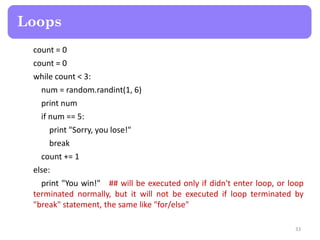
![choices = ['pizza', 'pasta', 'salad', 'nachos']
print 'Your choices are:'
for index, item in enumerate(choices):
print index+1, item # >> Your choices are: 1 pizza 2 pasta 3 salad 4
nachos
Loops
34](https://image.slidesharecdn.com/lecture5-pythonforraspberrypi-150819171856-lva1-app6891/85/Raspberry-Pi-Lecture-5-Python-for-Raspberry-Pi-34-320.jpg)


